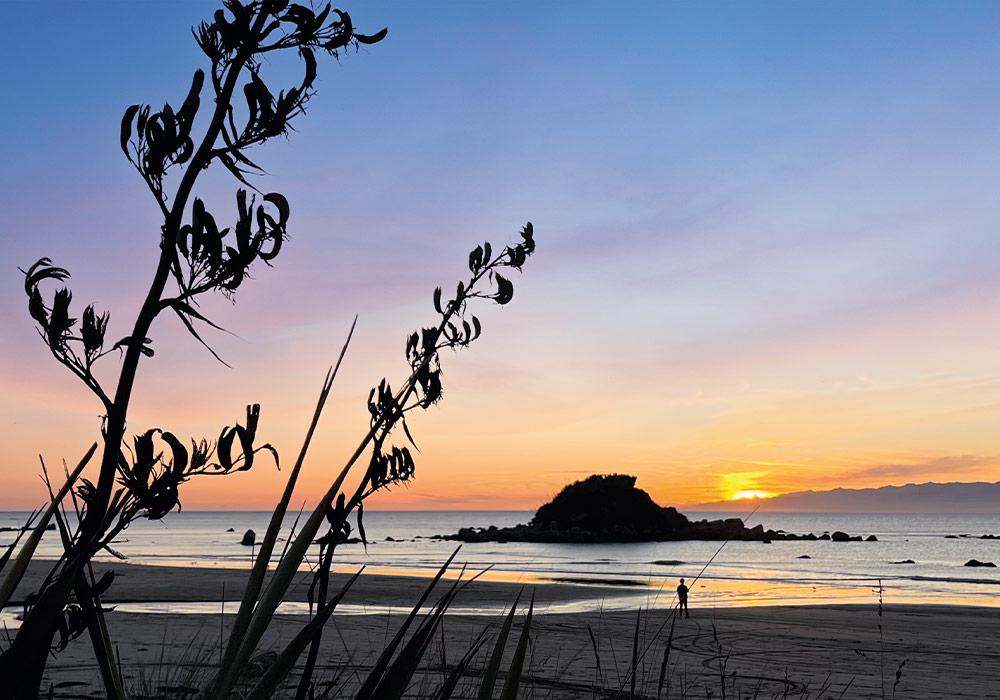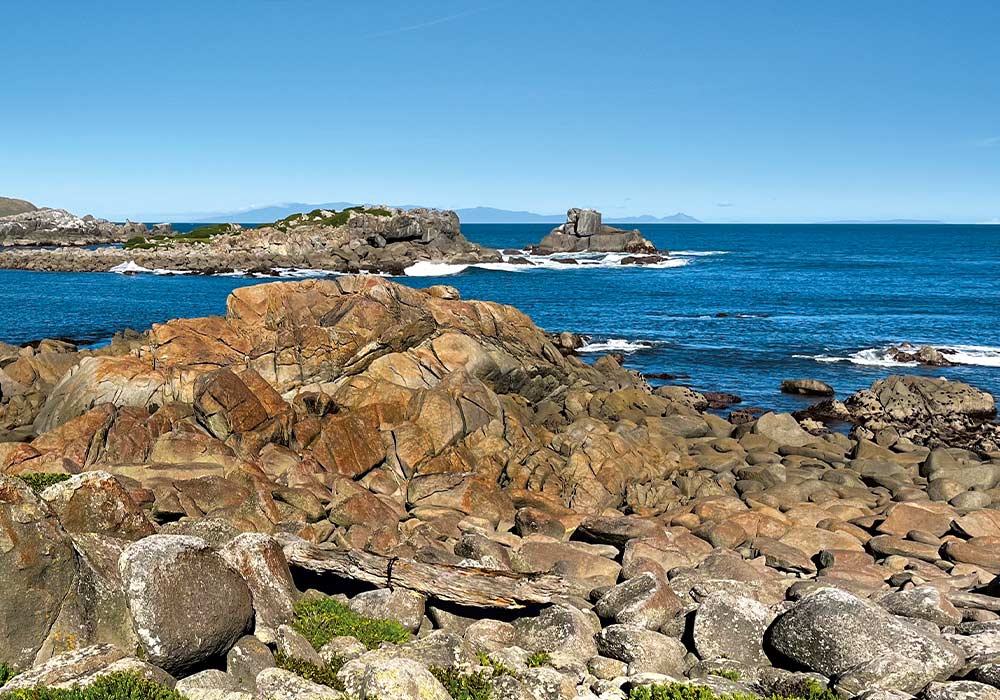Some of the best places to visit often receive only a fleeting mention in guidebooks (or not at all). And sometimes some of the most fun places to explore are along the roads as you drive between small towns and stopping points. When travelling in an RV, it pays to seek out tips from locals, as this is where some of the most special places can be found, as Jill Malcolm discovers while touring SH 99.
“I love Colac Bay,” said Jill, the stylist who was cutting my hair in Riverton, 40km west of Invercargill. “It’s just a wee bit further on.” She waved her scissors dangerously close to my ear to indicate the direction before continuing: “Good for swimming and super popular with surfers.”
On that recommendation, we drove west from Riverton, following SH 99 to the turn-off to Colac Bay. At that point, there was a tavern and campground and a large plaster effigy of a surfer in motion, which had seen better days. We’d seen better days ourselves.
Clouds were strung out over the sea like dirty washing and a bad-tempered wind was keening across the beach and whistling around the unadorned cribs that dot the foreshore. The bay is a great curve of ash-coloured sand that’s lined with huge boulders. The sea, the colour of pewter, was rather uninviting. We were not seeing Colac Bay at its best.
On the bay’s western point, we found a freedom camping area, which would have been enticing in benign weather. The only camper was a craggy-faced man in a well-lived-in Jayco motorhome. He had just come in from fishing.
“Great place for fishing; I got a good blue moki,” he said holding up a fat fish. “That’ll do for dinner. You might see Hector’s dolphins if you hang around here for a bit. Saw them yesterday.”
Hanging around didn’t feel appealing; as we drove further west, the sky cleared. We turned off Highway 99 to wind our way down the coast to Cosy Nook – a tiny cove reminiscent of a Scottish fishing village, which is cut into the coastline and defined by stacks of bulky boulders. Spurs of jagged rocks, like broken teeth, rose from the turmoil of crashing waves.
Half a dozen cribs were hunched along the shoreline and an old fishing boat named Snipe was disintegrating alongside a dishevelled caravan that would never see the road again. These were reminders of the time when crayfish and kina were collected from the rocky crevasses and a fleet of fishing boats found shelter from the turbulent sea.
Nobody lives here now. Cosy Nook’s most notable citizen was a man called Bob Blackwell, who for 27 years, lived in the stained timber crib that he called The Polyfilla Villa. Jocelyn Reece, who lives on a farm adjacent to Cosy Nook, knew him well.
“He was an independent, socially selective man with a robust sense of humour,” she said, “a good writer, a tinkerer, and a passionate gardener.”
Now he’s gone; nobody at all lives in the village. Grasses have smothered Bob’s garden, and insects and rats invade Polyilla Villa. But nailed to the front wall is a tribute: “Bob is not present at present, but his spirit and soul will always be. In loving memory of the wise man who taught people more than he was aware of.”
Orepuki tales

Back on SH 99, we came to a barely-there settlement called Orepuki, which is a ghost of what it was way back when gold had been discovered in the black sand nearby at Te Waewae Bay and later when the railway brought the area into focus.
The buildings in the main street have not long to live but, according to Alastair McCracken, the long-standing proprietor of Orepuki Tavern, things in Orepuki are looking up as a new wave of settlers come to town.
The tavern is a glimmer of life in the main street. Unremarkable from the outside, it’s lively and welcoming inside and promises a good dose of Southern hospitality served up with battered blue cod or Southern Seafood pizzas topped with, salmon, prawns, and mussels from Stewart Island. Next to the tavern, Alistair runs a POP, which also has a laundry. There’s more hospitality back on SH 99, where local farmers Penny Sonnenburg and Brian McGrath have turned an old colonial house into the Orepuki Beach Café. The house was built way back in 1885 by Captain Crowther of the Colonial Guard and so restoring it was no mean feat. The menu at Orepuki Café has now earned such favour that at weekends, it’s a popular destination for sybarites from Invercargill.
“It’s a genuinely farm-to-plate menu,” says Brian. “Our farm provides all the lamb and beef and vegetables and herbs are from our gardens. Of course, fish comes from the sea. Blue cod is a favourite, but I think the dishes we do best are created from our prime cuts of lamb. Our sought-after cakes are all baked in the café kitchen.”
Brian does not run a camping area as such but anyone who has dinner there is welcome to park in the paddock at the back of the house for the night.
A wee island

This was not to be our place of rest, however. We drove four more kilometres to the west intrigued by the name of Monkey Island Beach and where, according to my Riverton stylist, there was freedom camping on the shore.
RVers can stay for 28 days in this large area, which is separated by a low bank from a stunning stretch of sandy beach and a glittering expanse of sea. Time permitted us only four days, but we were blessed by a blue, cloud-brushed sky and the sun’s warmth draped over our shoulders like friendly arms. The campground is well looked after and has flushing toilets adorned with murals of sea life.
At one end of the beach, Monkey Island is a conical rock jutting skyward from the sea. Its name has nothing to do with the primate but refers to the ship-to-shore winch that used to haul boatloads of provisions in the days when there was no road or railway. The island can be reached at low tide and a 10-minute lung-taxing climb leads to its summit. Back in an earlier time, Māori used the island as a lookout for spotting Southern Right Whales.
Every evening, the sinking sun sets the seascape on fire. I sat outside late into the night with a German woman called Greta in the hope of catching Aurora Australis (Southern Lights). Even though the conditions were perfect, the Aurora was elusive, but the dark velvet sky dripped with stars. Strung out along the beach, fellow watchers sat around the fires they had lit to keep themselves warm.
By day we lounged and chatted with fellow campers, walked the beach, and flirted with the toe-tingling sea. We made an expedition to Gemstone Beach a few kilometres away. The beach itself is not a natural beauty but for me, it was a version of heaven as it was ankle-deep in coloured stones that had been tumbled by the tide. Among them, I might have found garnet, jasper, quartz, and nephrite but I didn’t.
I’m an addicted stone collector and a treasure hunt among such a plethora of pebbles filled me with joy. While Bill read a book in the van, I rummaged through these delights, joining the others who were pecking among the stones like a flock of pigeons. One mysterious aspect of Gemstone Beach is that the pebbles are not always there. One day they smother the beach and the next day the sea has claimed them and replaced them with sand.
Tuatapere township

We returned to our lovely spot at Monkey Island for another night and next day, moved further west toward the town of Tuatapere. This remote part of the country is dramatic with unfolding panoramas of sea and land. Trees and bushes were combed back from the coast by the persistent winds off Foveaux Strait. The lofty landscapes of Fiordland in the background looked intimidating even from a distance.
Tuatapere is an ex-sawmilling township on the fringe of New Zealand’s largest and most spectacular national park. It’s one of the kick-off points for several park adventures including the five-day Hump Ridge Walking Track. But the town’s most obvious claim to fame appears to be a sausage. To that end, there’s a welcoming roadside hoarding announcing it as the ‘Sausage Capital of New Zealand’. There’s not much sizzle in Tuatapere and not a snarler that I could see but I was told they are still being made at the Tui Base Campground in the township. The huge fibreglass snarler that once defined the town has gone but the logo of the town now depicts a laughing sausage wearing tramping boots and a backpack.
It was in Tuatapere that in the 1980s, a group of locals conceived the idea of establishing the Southern Scenic Route, a small portion of which we had just explored. For northern travellers, the drive from Riverton to Tuatapere may seem a long way south but when you get there, whatever the weather, it’s one of the spectacular corners of the country with a character uniquely its own.
Quick tips for exploring SH 99
- Have a look at the remarkable historic Clifden Suspension Bridge near Clifden, which is 14km north of Tuatapere and spans the Waiau River. A feature of the bridge is the Clifden Roll of Honour, set into the northern tower at the east end of the bridge.
- In Tuatapere, The Bushman’s Museum displays a comprehensive photographic display of the old timber milling day. There’s a static display of the milling equipment stories of the early settlers who lived around ‘The Hole in the Bush’ as Tuatapere was first known.
- The 62km Hump Ridge Walking Track is a three-day loop walk. It runs along the south coast of New Zealand and requires a good level of fitness. It wanders through the sub-alpine wilderness of native forests to sea-level views. The track is operated by the Department of Conservation and the Tuatapere Community and is run by a Charitable Trust. Hut bookings are essential, and the office is in the Bushman’s Museum building.
- Don’t miss the Te Hikoi Museum in Riverton, as it’s an opportunity to walk into the history of the South Island’s southern coast. In the one hour I spent there, I gained a smidgeon of understanding of the wild and isolated stretch of Riverton–Tuatapere coast. Riverton has always been a frontier town, a jump-off point to Southern Fiordland, Stewart and Codfish Islands, and so it has more than its fair share of good stories to be told.
- Orepuki Beach Café. If you’re down this way, do not skip past this surprisingly good rural restaurant in Orepuki on SH 99. Its wide selection of farm-to-plate menu and delicious cabinet food is memorable. The staff are obliging efficient and friendly and the ambience of the historic house and gardens is compelling. This is Southern hospitality at its best.






